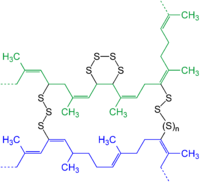
Photo from wikipedia
An interpenetrating polymer network (IPN) is a novel blend of two polymers at least one of which is synthesized or crosslinked in the immediate presence of the other so that… Click to show full abstract
An interpenetrating polymer network (IPN) is a novel blend of two polymers at least one of which is synthesized or crosslinked in the immediate presence of the other so that there is the least possibility of any gross phase separation. Full-IPNs, prepared from poly(vinyl alcohol) and polyacrylamide, have shown superior performances over the conventional individual polymers. The ranges of applications have grown rapidly for such class of materials. Cellulose nanoparticles extracted from sugarcane bagasse in-house are used to reinforce this PVA/PAAm (80:20) full-IPN in different proportions during the synthesis of IPN. The characteristics of this new series of IPN composite materials have been evaluated by Fourier transform infrared spectroscopic analysis, mechanical, thermal (thermogravimetric analysis and differential scanning calorimetry), and scanning electron microscopy techniques. A loading of 5 wt% of nanocellulose lead to the highest tensile strength amongst the different IPN composite films. Although the non-reinforced full-IPN and the various reinforced composites with nanocelluloses are almost identical in their thermal stability, they prove to be much superior compared to the neat polymers. POLYM. COMPOS., 38:1720–1731, 2017. © 2015 Society of Plastics Engineers
Journal Title: Polymer Composites
Year Published: 2017
Link to full text (if available)
Share on Social Media: Sign Up to like & get
recommendations!